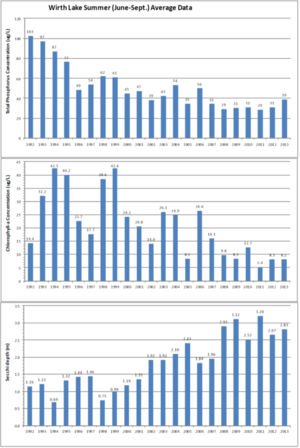
Case studies for monitoring to meet TMDL permit requirements
This site is in development
Lake Monitoring Case Study: Wirth Lake=
The Wirth Lake Excess Nutrients TMDL Report (MPCA, 2010) was approved in 2010 after Wirth Lake was originally listed for excess nutrient (phosphorus) impairment. Wirth Lake is a 38-acre lake with a maximum depth of 26 feet. All known phosphorus sources to Wirth Lake were considered in the development of the TMDL and the Wirth Lake Final TMDL Implementation Plan (https://www.pca.state.mn.us/sites/default/files/wq-iw11-03c.pdf). These sources include:
- Stormwater runoff from MS4s
- Permitted point sources other than MS4s
- Backflow from Bassett Creek during flood periods
- Atmospheric deposition
- nternal phosphorus loading
Stormwater from approximately 77 percent of the Wirth Lake watershed currently drains through some form of wet detention before it enters Wirth Lake. A significant untreated source of phosphorus to Wirth Lake occurs when flood flows in Bassett Creek backflow to Wirth Lake. Other sources include runoff from highway right-of-ways and sediment release of phosphorus (i.e., internal phosphorus loading).
| Comparison of historical and 10-year (1999-2008) water quality data to applicable water quality standards (MPCA, 2010) | |||
| Water quality parameter | MPCA deep lake eutrophication standards (NCHF Ecoregion) | Wirth Lake historical (1992-2008) growing season average | Wirth Lake 10-year (1999-2008) growing season average |
|---|---|---|---|
| Total phosphorus (ug/L) | < 40 | 55 | 41 |
| Chlorophyll a (ug/L) | <14 | 22 | 18 |
| Secchi disk (m) | < 1.4 | 1.8 | 2.0 |
A watershed P8 model, calculated Bassett Creek backflow phosphorus loads, and observed lake water quality data were used to calibrate the Wirth Lake BATHTUB model to average observed total phosphorus concentration during the 2005-2006 water year. The BATHTUB model calibrated to observed total phosphorus concentration (TP) was used to determine the best models for predicting the observed chlorophyll-a concentration and Secchi disc transparency (SD). The calibrated BATHTUB model was then validated for the 2006-2007 water year (i.e., results generated using the calibrated BATHTUB model were compared to in-lake water quality observations). Table 4 compares in-lake water quality observations to BATHTUB model results for the calibration and validation time periods. The calibrated BATHTUB model was then used to predict how the lake water quality would change if the Wirth Lake outlet were configured to completely prevent backflow from Bassett Creek. Table 4 shows that this improvement option would decrease in-lake TP concentration for the 2005-2006 water year from 46 to 38 μg/L and that both TP and SD would meet the eutrophication criteria for Wirth Lake.
In 2012, a new lake outlet structure was installed to prevent backflow events from Basset Creek from deteriorating Wirth Lake’s water quality. In 2013, the 10-year average of the most recent water quality data (2003-2012) indicated that Wirth Lake met the MPCA deep lake standards for TP and SD. The 10-year average chl-a concentration for Wirth Lake was 14.7 µg/L, which was within 1 µg/L of the 14 µg/L chl-a criteria. If water quality monitoring data from 2013 is considered, the 10-year (2004-2013) average chl-a concentration for Wirth Lake becomes 12.9 µg/L, while the 10-year average TP (32.5 µg/L) and SD (2.56 m) are both significantly better than the respective listing criteria. Additionally, historic water quality data trend analysis indicated that, over the entire water quality monitoring data period (1992-2013), there have been significant improvements for all three water quality criteria at the 95 percent confidence level. The same is true for the trend analysis of the more recent data (2003-2012). Based on this evidence, Wirth Lake was delisted for lake eutrophication/excess phosphorus in 2014 and the tributary MS4s are no longer required to develop a compliance schedule or address this impairment in annual reporting. Wirth Lake average TP concentrations, chl-a concentrations, and SD depths for the period of 1992-2013 are shown in Figure 1.
